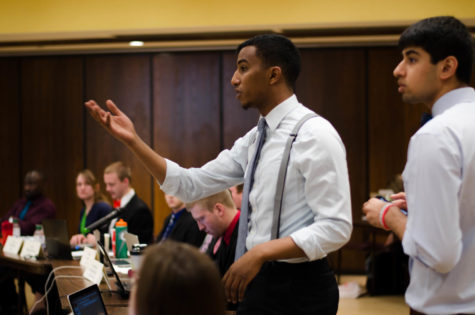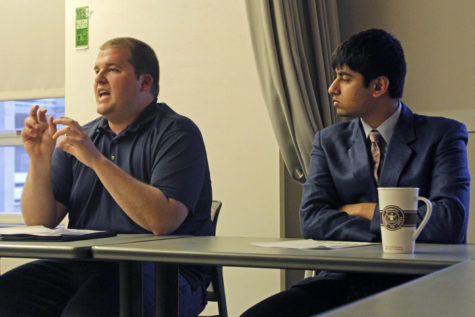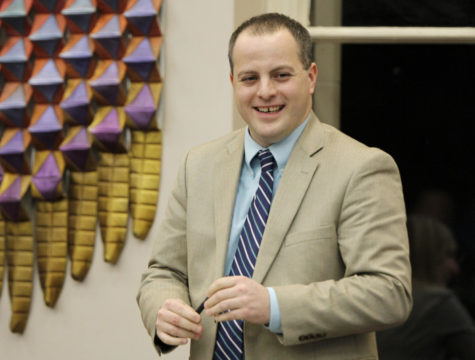The Future of the Union
February 21, 2003
Editor’s Note: This is the last article in a three-part series about the past, present and future of Iowa State’s Memorial Union.
The recent transfer of the Memorial Union from student ownership to university ownership paves the path for future renovations and additions.
The union was built in 1928 to serve as a “living memorial” to the students who lost their lives during World War I. The purpose of the building has always been to serve students’ needs, said Kathy Svec, marketing coordinator for the union.
An independent group called the Iowa State Memorial Union Corporation was formed to provide financially for the union; the university was unable to supply funding for the project at the time.
The agreement among the corporation, the Government of the Student Body, Iowa State and the Iowa Board of Regents to transfer ownership from ISU students to the university was effective Jan. 1.
The transfer, due to the wide range of entities and paperwork it effects, will not be complete until April 1 at the earliest, said GSB President T.J. Schneider.
Necessary steps of change
“Our union may have survived, but it hasn’t thrived,” said Thomas Hill, vice president for Student Affairs and member of the Memorial Union Board of Directors, which is comprised of students, alumni and administration.
The needed renovations and dated rooms are a result of being an operation independent of the university with limited resources. Like a computer, the union needs to be updated as advancements in technology come along, including televisions, computers, Internet access and many other needed services, he said.
“Every square inch of the building has been looked at for renovations,” said Andy Tofilon, former president of the corporation and former GSB president.
All unions are similar to each other; they provide the same basic services such as meeting rooms, recreation facilities, ballrooms and food services. However, each union is unique to its campus, said Memorial Union Director Mary Jo Mertens.
Iowa State’s union is different than other unions due to ownership. University-owned unions received money before student-owned unions did, she said.
Access as a priority
Architects working on the union’s plans have asked board members to prioritize the needs of the union, Mertens said.
Safety, fire code and handicapped-accessibility issues are being addressed first, Svec said.
“The handicap access is woefully inadequate,” she said. “After the renovations, we hope to have better access to services already provided.”
Ideas for renovations include the addition of an access point in front of the glass windows located on the east side of the union between the parking ramp.
A new corridor would be created as part of an access point to the union and the present hallway would become additional rooms. The goal of this project is to eventually provide elevator access to every level of the union and the parking ramp.
“Students are concerned with [the Americans with Disabilities Act] regulations,” Mertens said. “They want fellow students who are wheelchair-bound to have easy access to the union.”
Todd Herriott, director of the Disability Resource Center, said the union suffers from numerous accessibility problems. On the main floor, there are no clearly visible handicapped restrooms.
The restrooms on the main floor have small doors, the sinks are too high for effective use, paper towels are hard to reach and the stalls themselves are small. The only handicapped rest rooms are on the ground floor, he said.
Entrance to the union is also difficult. There is an entrance on the east side, but access to the building is a long route. The west doors allow for access to student accounting and recreation, but to go anywhere else in the union requires the use of an elevator lift. The key is located in the Maintenance Shop or at the front desk, Herriott said.
The most “unforgivable” access problem is the Sun Room — where orientation activities and lectures are held. A student in a wheelchair must either travel through the Great Hall or through the kitchen, he said.
“While it gets them there, it is not equal access,” Herriott said.
Herriott said students have told him the inaccessibility makes them feel like they are “second-class citizens.” A number of students don’t attend events in the Sun Room because they know it is difficult to reach, he said.
As a state facility, the union will now be required to be handicap accessible to comply with the Americans with Disabilities Act, Herriott said.
Herriott said he is hopeful the university will request input from Arvid Osterberg, professor of architecture, who spends time working on campus accessibility, the ADA transition task force, the Committee on Disabilities and the Disability Resource office.
Renovations on the first floor will create a quicker entrance and exit from the east entrance into the Sun Room. Access to the building from the south side is being considered. Mertens said the goal is to make the union look inviting from Lincoln Way.
Advancing technology
Bringing meeting rooms up-to-date with technology is another goal. Mertens said she wants the union to be a pleasant place, where students and staff aren’t embarrassed to bring their guests.
The guest rooms in the union are their showing age. The union is the only place for guests to stay on campus. The union’s central location allows visitors to look at the campus on their own and get a sense of what it is like, she said.
People who work in the hotel industry know rooms need to be upgraded every 10 years, Mertens said. The union’s facilities have not been renovated on that time schedule. “I’m sure you could find plumbing from 1928 somewhere up there,” she said.
Laura Corbin, the union’s guest rooms main desk manager, said she is hoping the university can make the rooms more usable for guests. The spring-loaded faucets, which are separate for hot and cold, are in the rooms now. She said she would also like to have an updated heating and cooling system, which would allow for climate control in the room.
Some of the furnishings are old, and Corbin said it would be nice for the rooms to be more modern. A lot of rooms have two twin beds, which is not common for hotels. The rooms are also quite small and described as “cozy European,” she said.
Time and money
Renovations will be done in phases. Mertens said there is no way the union could be closed and renovated all at once. The amount of funding available at the time of renovations is also taken into consideration.
With the university now in charge of union operations, tuition money can be legitimately spent on repairs and renovations, Hill said.
The $15 million obtained through student fees can be bonded immediately. The other money for renovations will come from alternate sources. President Gregory Geoffroy and the ISU Foundation have set the union as a priority item on their fund-raising lists, Mertens said.
Some traditions of the union will stay, but others need to change to meet the needs of students, Hill said.
“We want everyone to say ‘Meet me in the union,’ ” Hill said.
The union will commemorate its 75th anniversary this fall. A big celebration is being planned and will be used to “showcase the future plans,” Svec said.









